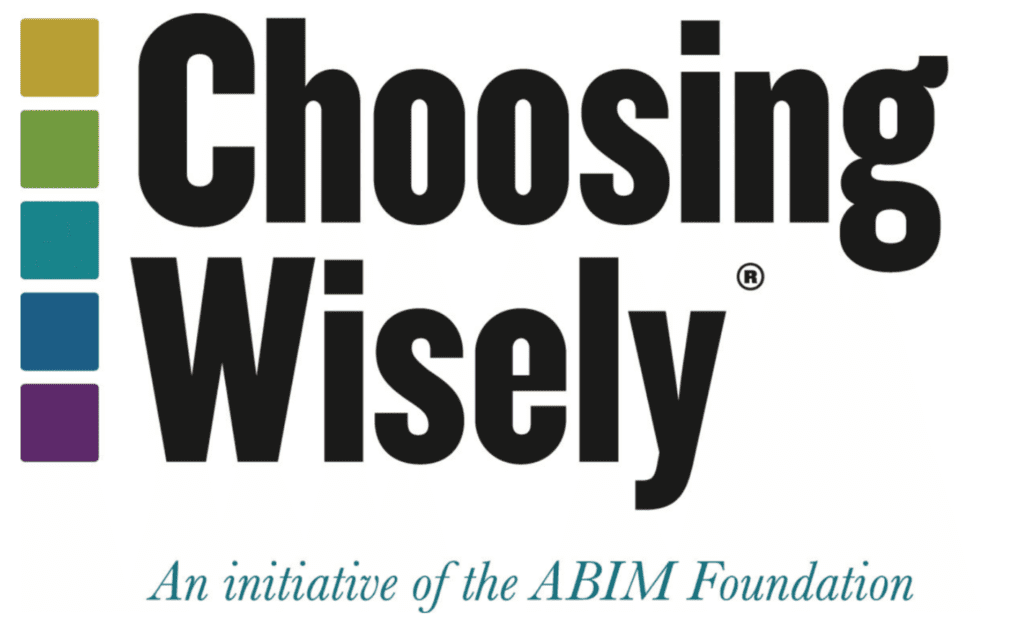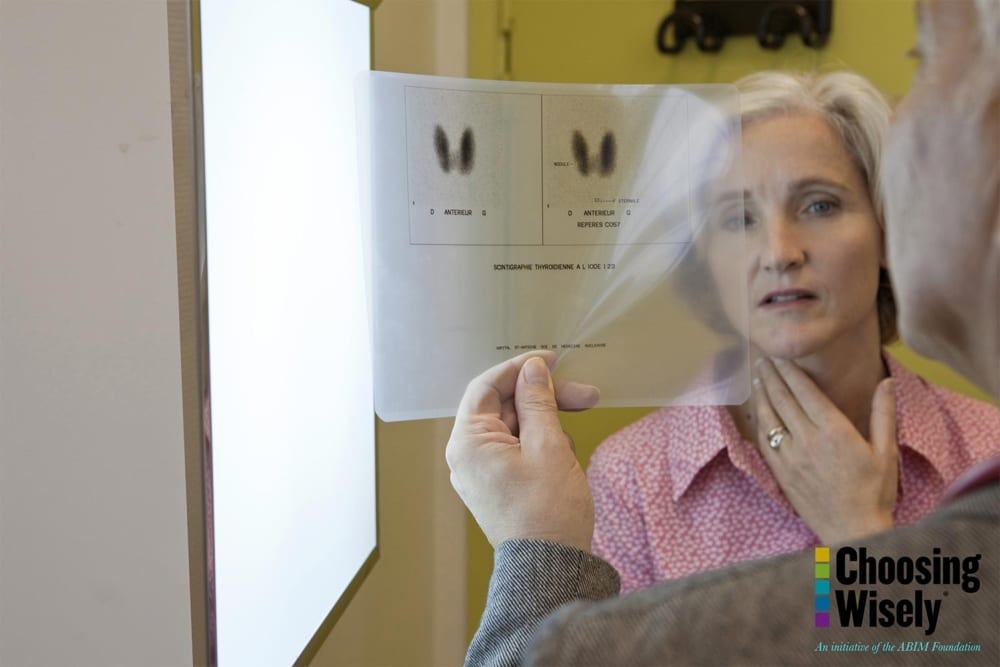Last updated: June 2019
The American Academy of Otolaryngology—Head and Neck Surgery Foundation (AAO-HNSF) is proud to have joined with other specialty groups in releasing lists of “Five Things Physicians and Patients Should Question.” The Foundation’s newest recommendations are items six through 10.
This initiative, led by the ABIM Foundation, aims to spark conversations about appropriate care between physicians and patients.
The AAO-HNSF‘s lists of recommendations were carefully selected after a review of the current evidence that included AAO-HNSF clinical practice guidelines. Each list includes language communicating when a particular test or treatment may be appropriate based on clinical evidence and guidelines. Consumer Reports, along with a coalition of consumer partner organizations, is also a part of the Choosing Wisely effort and is working with many of the societies to help patients understand the tests and treatments that are right for them.
Things Physicians & Patients Should Question:
Don’t order computed tomography (CT) scan on the head/brain for sudden hearing loss.
Computed tomography scanning is expensive, exposes the patient to radiation and offers no useful information that would improve initial management. CT scanning may be appropriate in patients with focal neurologic findings, a history of trauma or chronic ear disease.
Don’t prescribe oral antibiotics for uncomplicated acute tympanostomy tube otorrhea.
Oral antibiotics have significant adverse effects and do not provide adequate coverage of the bacteria that cause most episodes; in contrast, topically administered products do provide coverage for these organisms. Avoidance of oral antibiotics can reduce the spread of antibiotic resistance and the risk of opportunistic infections.
Don’t prescribe oral antibiotics for uncomplicated acute external otitis.
Oral antibiotics have significant adverse effects and do not provide adequate coverage of the bacteria that cause most episodes; in contrast, topically administered products do provide coverage for these organisms. Avoidance of oral antibiotics can reduce the spread of antibiotic resistance and the risk of opportunistic infections.
Don’t obtain radiographic imaging for patients who meet diagnostic criteria for uncomplicated acute rhinosinusitis.
Imaging of the paranasal sinuses, including plain film radiography, computed tomography (CT) and magnetic resonance imaging (MRI) is unnecessary in patients who meet the clinical diagnostic criteria for uncomplicated acute rhinosinusitis. Acute rhinosinusitis is defined as up to four weeks of purulent nasal drainage (anterior, posterior or both) accompanied by nasal obstruction, facial pain-pressure-fullness or both. Imaging is costly and exposes patients to radiation. Imaging may be appropriate in patients with a complication of acute rhinosinusitis, patients with comorbidities that predispose them to complications and patients in whom an alternative diagnosis is suspected.
Don’t obtain computed tomography (CT) or magnetic resonance imaging (MRI) in patients with a primary complaint of hoarseness prior to examining the larynx.
Examination of the larynx with mirror or fiberoptic scope is the primary method for evaluating patients with hoarseness. Imaging is unnecessary in most patients and is both costly and has potential for radiation exposure. After laryngoscopy, evidence supports the use of imaging to further evaluate 1) vocal fold paralysis, or 2) a mass or lesion of the larynx.
The American Academy of Otolaryngology—Head and Neck Surgery Foundation’s (AAO-HNSF) Patient Safety and Quality Improvement (PSQI) Committee was charged with developing the Foundation’s recommendations for the Choosing Wisely campaign. The PSQI Committee initially sought the input of the Specialty Society Advisory Council (SSAC) and requested each member society submit potential topics along with supporting evidence. From those submissions, an initial list of 20 items was distributed to Academy and Foundation committees and the Guidelines Development Task Force (GDTF) for review.
PSQI Committee leadership reviewed feedback from the committees and identified six potential recommendations for inclusion in the campaign. The six topics were selected based on their supporting evidence (for example, clinical practice guidelines), committee support, and the current use (frequency) of the test or procedure. The members of SSAC ranked the six topics, and the top five topics were submitted to the Foundation board for approval.
SOURCES
1. STACHLER RJ, CHANDRASEKHAR SS, ARCHER SM, ROSENFELD RM, SCHWARTZ SR, BARRS DM, BROWN SR, FIFE TD, FORD P, GANIATS TG, HOLLINGSWORTH DB, LEWANDOWSKI CA, MONTANO JJ, SAUNDERS JE, TUCCI DL, VALENTE M, WARREN BE, YAREMCHUK KL, ROBERTSON PJ. CLINICAL PRACTICE GUIDELINE: SUDDEN HEARING LOSS. OTOLARYNGOL HEAD NECK SURG [INTERNET]. 2012 MAR [CITED 2012 OCT 18];146(3 SUPPL):S1-35.
2. GOLDBLATT EL, DOHAR J, NOZZA RJ, NIELSEN RW, GOLDBERG T, SIDMAN JD, SEIDLIN M. TOPICAL OFLOXACIN VERSUS SYSTEMIC AMOXICILLIN/CLAVULANATE IN PURULENT OTORRHEA IN CHILDREN WITH TYMPANOSTOMY TUBES. INT J PEDIATR OTORHINOLARYNGOL. 1998 NOV 15;46(1-2):91-101.
3. ROSENFELD RM, SCHWARTZ SR, PYNNONEN MA, TUNKEL DE, HUSSEY HM, FICHERA JS, GRIMES AM, HACKELL JM, HARRISON MF, HASKELL H, HAYNES DS, KIM TW, LAFRENIERE DC, LEBLANC K, MACKEY WL, NETTERVILLE JL, PIPAN ME, RAOL NP, SCHELLHASE KG. CLINICAL PRACTICE GUIDELINE: TYMPANOSTOMY TUBES IN CHILDREN. OTOLARYNGOL HEAD NECK SURG. 2013 JUL;149(1 SUPPL):S1-35.
ROSENFELD RM, SCHWARTZ SR, CANNON CR, ROLAND PS, SIMON GR, KUMAR KA, HUANG WW, HASKELL HW, ROBERTSON PJ. CLINICAL PRACTICE GUIDELINE: ACUTE OTITIS EXTERNA. OTOLARYNGOL HEAD NECK SURG. 2014 FEB;150(1 SUPPL):S1-S24.
4. ROSENFELD RM, PICCIRILLO JF, CHANDRASEKHAR SS, BROOK I, KUMAR KA, KRAMPER M, ORLANDI RR, PALMER JN, PATEL, ZM, PETERS A, WALSH S, CORRIGAN MD. CLINICAL PRACTICE GUIDELINE: ADULT SINUSITIS. OTOLARYNGOL HEAD NECK SURG. 2015 APR;152(2 SUPPL):S1-S39.
5. SCHWARTZ SR, COHEN SM, DAILEY SH, ROSENFELD RM, DEUTSCH ES, GILLESPIE MB, GRANIERI E, HAPNER ER, KIMBALL CE, KROUSE HJ, MCMURRAY JS, MEDINA S, O’BRIEN K, OUELLETTE DR, MESSINGER-RAPPORT BJ, STACHLER RJ, STRODE S, THOMPSON DM, STEMPLE JC, WILLGING JP, COWLEY T, MCCOY S, BERNAD PG, PATEL MM. CLINICAL PRACTICE GUIDELINE: HOARSENESS (DYSPHONIA). OTOLARYNGOL HEAD NECK SURG [INTERNET]. 2009 SEP [CITED 2012 OCT 18];141(3 SUPPL 2):S1-S31.
Don’t place ear tubes in otherwise healthy children who have had a single episode of ear fluid lasting less than three months.
Ear fluid of short duration is likely to resolve spontaneously. The child should be monitored to ensure resolution of the fluild. In children with comorbid conditions or speech delay, earlier tube placement may be appropriate.
Don’t order imaging studies in patients with non-pulsatile bilateral tinnitus, symmetric hearing loss and an otherwise normal history and physical examination.
The utility of imaging procedures in primary tinnitus is undocumented; imaging is costly, has potential for radiation exposure and does not change management.
Don’t order more than one computerized tomography (CT) scan of the paranasal sinuses within 90 days to evaluate uncomplicated chronic rhinosinusitis patients when the paranasal sinus CT obtained is a adequate quality and resolution to be interpreted by the clinician and used for clinical decision-making and/or surgical planning.
Computerized tomography scanning is expensive, exposes the patient to ionizing radiation and offers no additi onal information that would improve initial management. Multiple CT scans within 90 days may be appropriate in patients with complicated sinusitis or where an alternative diagnosis is suspected.
Don’t administer or prescribe perioperative antibiotics to children undergoing tonsillectomy.
Oral antibiotics may have significant adverse effects and do not provide demonstrable benefit after tonsillectomy. Avoidance of oral antibiotics can reduce the spread of antibiotic resistance and the risk of opportunistic infections.
Don’t routinely perform sinonasal imaging in patients with symptoms limited to a primary diagnosis of allergic rhinitis alone.
History, physical examination and allergy testing are the cornerstones of diagnosis of allergic rhinitis. The utility of imaging for allergic rhinitis is unproven.
The American Academy of Otolaryngology—Head and Neck Surgery Foundation’s (AAO-HNSF) Patient Safety and Quality Improvement (PSQI) Committee was charged with developing a second AAO-HNSF list. The PSQI Committee sought the input of the Specialty Society Advisory Council (SSAC) and requested each member society submit a list of potential topics along with supporting evidence. From the submissions received, an initial list of proposed topics was developed and distributed to Academy and Foundation committees and the Guidelines Development Task Force (GDTF) for review. Committees were asked to provide their support for any of the proposed topics, reasons why a topic should not be included, as well as identifying any additional topics for consideration along with supporting evidence.
PSQI Committee leadership reviewed all submitted feedback and identified seven potential topics for inclusion in the campaign. The seven topics were selected based on their supporting evidence (for example, AAO-HNSF clinical practice guidelines), committee support, and the current use (frequency) of the test or procedure. The members of SSAC were asked to rank the seven topics; the seven topics were submitted to the AAO-HNSF Board for approval and the top five were submitted to the Choosing Wisely campaign.


